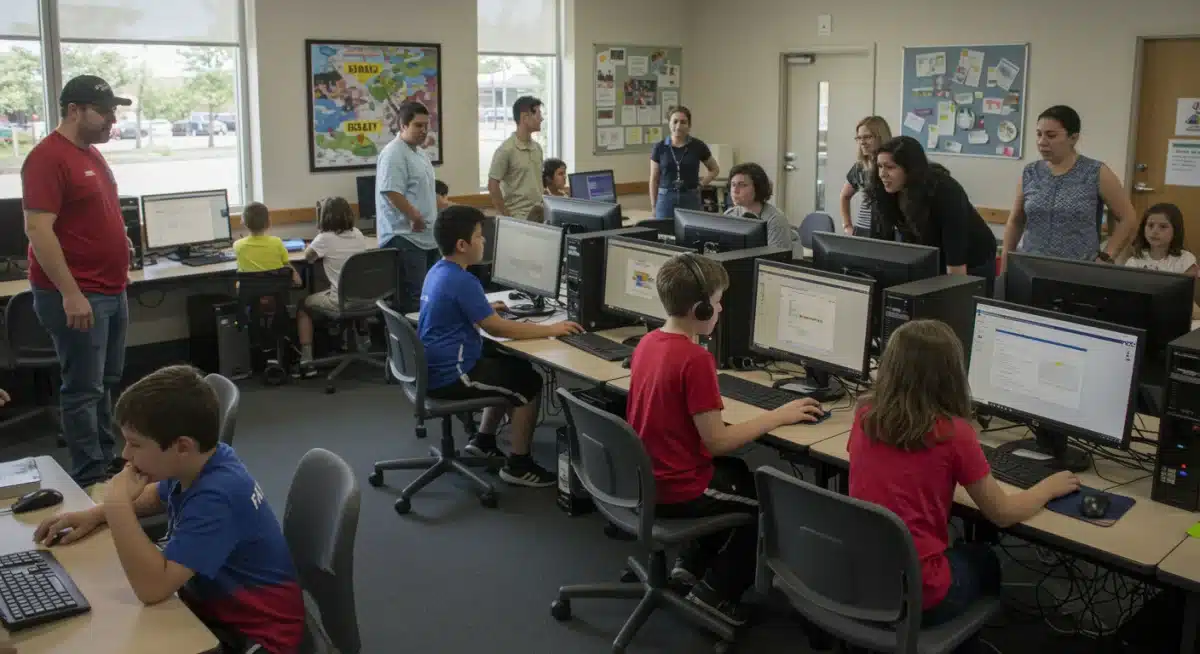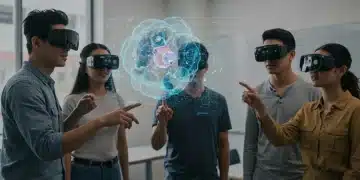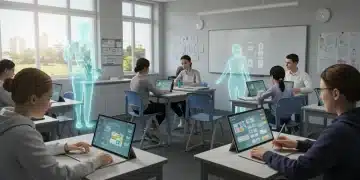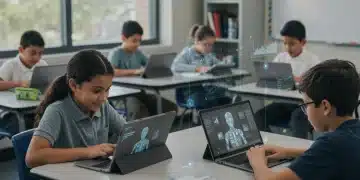Addressing Digital Divide in Education: 6 Solutions for Equitable Access by 2025

The ongoing effort to close the digital divide in education by June 2025 focuses on implementing strategic, actionable solutions to ensure all students have equitable access to necessary technology and internet connectivity.
As of today, the persistent challenge of Addressing the Digital Divide in Education: 6 Practical Solutions for Equitable Access by June 2025 is at the forefront of global educational policy. This critical issue impacts millions, hindering learning opportunities and perpetuating inequalities. What steps are being taken now to ensure every student has the tools they need for a modern education?
Ensuring Ubiquitous High-Speed Internet Access
The foundation of equitable digital education rests on universal access to reliable, high-speed internet. Current initiatives are accelerating efforts to bridge connectivity gaps, particularly in rural and underserved urban areas. Governments and private sector partners are collaborating to expand infrastructure and provide subsidized services, aiming for comprehensive coverage by the 2025 deadline.
Key strategies involve leveraging diverse technologies and funding models to reach every household. This includes not only fiber optic expansion but also satellite internet solutions and fixed wireless broadband to overcome geographical barriers. The goal is to ensure that internet access is not just available, but also affordable and of sufficient quality to support online learning for all students.
Public-Private Partnerships for Infrastructure
Collaborations between public entities and private telecommunications companies are proving crucial. These partnerships help share the financial burden and expertise required to deploy advanced network infrastructure.
- Government Subsidies: Programs like the Affordable Connectivity Program (ACP) offer discounts on internet service and devices for eligible low-income households.
- Infrastructure Grants: Federal and state grants are being allocated to expand broadband networks in areas historically lacking adequate service.
- Community Wi-Fi Initiatives: Local governments and non-profits are establishing free public Wi-Fi hotspots in community centers, libraries, and schools.
Providing Access to Essential Learning Devices
Beyond internet access, students require appropriate devices to engage with digital learning content. The provision of laptops, tablets, and other necessary hardware is a central pillar in the effort to achieve equitable access. Many school districts and educational organizations are implementing one-to-one device programs, ensuring every student has a dedicated tool for their studies.
This involves careful planning for procurement, distribution, and maintenance of devices. Schools are exploring various financing options, including federal aid, state funding, and philanthropic donations. Emphasis is placed on providing robust, user-friendly devices that can withstand daily use and support a wide range of educational applications.
Device Distribution Models
Different models are being tested to efficiently distribute devices to students, addressing the diverse needs of various communities.
- One-to-One Programs: Schools provide each student with a device for use both at school and at home.
- Device Lending Libraries: Libraries and community centers offer short-term device loans to students who need them.
- Refurbished Device Initiatives: Programs collect, refurbish, and redistribute used devices to students and families in need, promoting sustainability.
Developing Robust Digital Literacy Programs
Having internet and devices is only part of the solution; students, parents, and educators must also possess the skills to effectively use these tools. Digital literacy programs are being scaled up to ensure all stakeholders are proficient in navigating online environments, utilizing educational software, and understanding digital citizenship.
These programs address a broad spectrum of skills, from basic computer operation to critical thinking about online information and cybersecurity awareness. Training is being tailored to different age groups and skill levels, with dedicated support for parents and guardians to help them assist their children’s digital learning journeys. The aim is to empower individuals to fully harness the potential of digital resources.
Curriculum Integration and Teacher Training
Digital literacy is increasingly being integrated into the core curriculum, moving beyond standalone lessons to become an inherent part of learning across subjects. Simultaneously, comprehensive training for educators is paramount.
- Teacher Professional Development: Ongoing training ensures educators are proficient in using digital tools and integrating them effectively into their teaching practices.
- Parental Workshops: Sessions designed for parents help them understand and support their children’s digital learning, including online safety and resource navigation.
- Student Skill Development: Age-appropriate curricula focus on essential digital skills, critical evaluation of online content, and responsible online behavior.
Creating Accessible Digital Content and Platforms
The availability of high-quality, accessible digital learning content and platforms is crucial for equitable education. Efforts are underway to ensure that all digital resources, from e-textbooks to interactive modules, are designed with accessibility in mind, catering to students with diverse learning needs and disabilities.
This includes adherence to accessibility standards (e.g., WCAG guidelines) and the development of platforms that offer features such as screen readers, alternative text for images, and customizable display options. Publishers and educational technology companies are collaborating with educators and accessibility experts to create inclusive digital learning environments. The focus is on ensuring that technology removes barriers, rather than creating new ones.

Implementing Targeted Support for Vulnerable Populations
While broad initiatives are essential, specific, targeted support is critical for vulnerable populations disproportionately affected by the digital divide. This includes students from low-income households, those with disabilities, English language learners, and students in foster care or experiencing homelessness.
Programs are being designed to provide personalized assistance, including dedicated digital navigators, specialized equipment, and culturally relevant educational resources. Partnerships with social service agencies and community organizations are vital for identifying these students and delivering tailored interventions. The goal is to address the unique challenges faced by each group to ensure no student is left behind in the digital learning landscape.
Fostering Community-Based Learning Hubs
Community-based learning hubs are emerging as powerful solutions to provide access and support beyond the traditional classroom setting. These hubs, often located in libraries, community centers, or non-profit organizations, offer free internet access, devices, and on-site technical assistance and tutoring. They serve as vital resources, especially for students who lack adequate home learning environments.
These centers are not just about technology provision; they also foster a supportive learning community. They provide a safe space for students to complete homework, collaborate on projects, and receive personalized academic help. The expansion of such hubs is a strategic move to create accessible learning environments that complement school-based initiatives and address the multifaceted nature of the digital divide.
| Key Solution Area | Brief Description |
|---|---|
| High-Speed Internet | Ensuring universal, affordable, and reliable internet access for all students, especially in underserved regions. |
| Device Provision | Implementing one-to-one device programs and lending initiatives to equip every student with necessary hardware. |
| Digital Literacy | Developing comprehensive programs to foster digital skills for students, parents, and educators. |
| Accessible Content | Creating inclusive digital learning materials and platforms that meet accessibility standards for all learners. |
Frequently Asked Questions About the Digital Divide
The digital divide in education refers to the gap between students who have access to technology and the internet for learning and those who do not. This disparity can stem from socio-economic status, geographic location, or disability, significantly impacting educational outcomes and opportunities.
Addressing the digital divide by June 2025 is critical to ensure educational equity and prepare all students for a future increasingly reliant on digital skills. Without equitable access, disparities in learning and future career prospects will widen, undermining societal progress and individual potential.
Schools can bridge the digital divide by implementing one-to-one device programs, providing internet hotspots, offering digital literacy training, and creating community learning hubs. Collaborating with local governments and non-profits is also essential to maximize reach and impact.
Parents play a vital role by participating in digital literacy workshops, ensuring their children utilize provided devices and internet access, and advocating for resources in their communities. Their engagement helps create a supportive home learning environment and reinforces school efforts.
Yes, numerous government programs, such as the Affordable Connectivity Program (ACP), offer subsidies for internet service and devices to eligible low-income families. Federal and state grants also fund broadband infrastructure expansion in underserved areas, directly supporting equitable digital access initiatives.
What Happens Next
As the June 2025 target approaches, the focus intensifies on the measurable impact of these six solutions. Policy makers are closely monitoring implementation, with ongoing assessments expected to highlight successes and areas requiring further intervention. The coming months will see accelerated efforts in last-mile connectivity, device distribution, and the scaling of digital literacy programs to ensure no student is left without the tools for a modern education. Expect further reports on regional progress and the emergence of new best practices.





